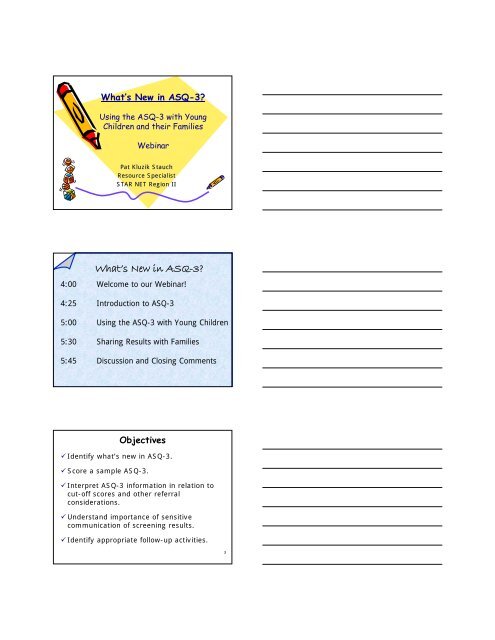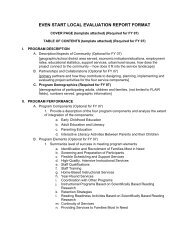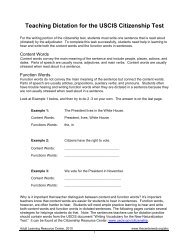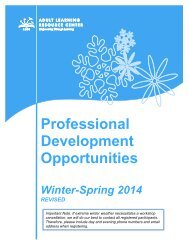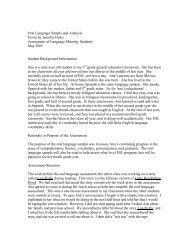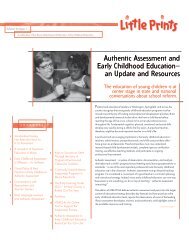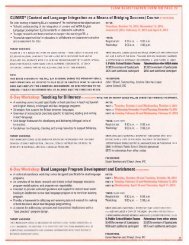What's New in ASQ-3? - The Center
What's New in ASQ-3? - The Center
What's New in ASQ-3? - The Center
Create successful ePaper yourself
Turn your PDF publications into a flip-book with our unique Google optimized e-Paper software.
What’s <strong>New</strong> <strong>in</strong> <strong>ASQ</strong>-3?<br />
Us<strong>in</strong>g the <strong>ASQ</strong>-3 with Young<br />
Children and their Families<br />
Web<strong>in</strong>ar<br />
Pat Kluzik Stauch<br />
Resource Specialist<br />
STAR NET Region II<br />
What’s <strong>New</strong> <strong>in</strong> <strong>ASQ</strong>-3?<br />
4:00 Welcome to our Web<strong>in</strong>ar!<br />
4:25 Introduction to <strong>ASQ</strong>-3<br />
5:00 Us<strong>in</strong>g the <strong>ASQ</strong>-3 with Young Children<br />
5:30 Shar<strong>in</strong>g Results with Families<br />
5:45 Discussion and Clos<strong>in</strong>g Comments<br />
2<br />
Objectives<br />
Identify what’s new <strong>in</strong> <strong>ASQ</strong>-3.<br />
Score a sample <strong>ASQ</strong>-3.<br />
Interpret <strong>ASQ</strong>-3 <strong>in</strong>formation <strong>in</strong> relation to<br />
cut-off scores and other referral<br />
considerations.<br />
Understand importance of sensitive<br />
communication of screen<strong>in</strong>g results.<br />
Identify appropriate follow-up activities.<br />
3
<strong>ASQ</strong>-3 and Developmental<br />
Screen<strong>in</strong>g of Young Children<br />
4<br />
What are we talk<strong>in</strong>g about?<br />
Assessment<br />
process of obta<strong>in</strong><strong>in</strong>g<br />
<strong>in</strong>formation for the purposes of<br />
mak<strong>in</strong>g decisions<br />
Screen<strong>in</strong>g<br />
a quick assessment process<br />
used to determ<strong>in</strong>e if a child<br />
needs further evaluation<br />
5<br />
Screen<strong>in</strong>g<br />
Beyond Cutoff<br />
Near Cutoff<br />
Not Near Cutoff<br />
Refer for<br />
Evaluation<br />
Eligible<br />
Not Eligible<br />
Monitor/Re-Screen<br />
Develop learn<strong>in</strong>g plans<br />
based on Curriculum-<br />
Based Assessment<br />
6
Reasons for Screen<strong>in</strong>g Children<br />
To refer children for evaluation<br />
To meet federal, state and program<br />
requirements<br />
To monitor the development of children<br />
that do not have disabilities<br />
To connect parents with local resources<br />
Other reasons?<br />
7<br />
Referral<br />
And More Def<strong>in</strong>itions<br />
process of connect<strong>in</strong>g parents with other agencies<br />
for purposes of evaluation and/or service<br />
Evaluation<br />
process of us<strong>in</strong>g assessment <strong>in</strong>formation to make<br />
comparisons and decisions; process of identify<strong>in</strong>g a<br />
delay or disability<br />
Monitor<strong>in</strong>g<br />
periodic developmental screen<strong>in</strong>g<br />
8<br />
Parent Report and <strong>ASQ</strong>-3<br />
Parents are reservoirs of rich <strong>in</strong>formation<br />
Parental <strong>in</strong>volvement reduces cost<br />
Screen<strong>in</strong>g helps structure observations,<br />
reports and communications about child<br />
development<br />
Screen<strong>in</strong>g can be used as a teach<strong>in</strong>g tool<br />
Source: <strong>ASQ</strong> and <strong>ASQ</strong>:SE tra<strong>in</strong><strong>in</strong>g, University of Oregon, 2004<br />
9
Accuracy <strong>in</strong> Parent Report<br />
As accurate as formal measures for identify<strong>in</strong>g<br />
cognitive delay (Glascoe, 1989, 1990; Pulsifer, 1994)<br />
As accurate as formal measures for identify<strong>in</strong>g<br />
language delay (Tombl<strong>in</strong>, 1987)<br />
As accurate as formal measures for identify<strong>in</strong>g<br />
symptoms of ADHD and school related problems<br />
(Mulhern, 1994)<br />
More accurate than Denver for predict<strong>in</strong>g school-age<br />
learn<strong>in</strong>g problems (Diamond, 1987)<br />
Source: <strong>ASQ</strong> and <strong>ASQ</strong>:SE tra<strong>in</strong><strong>in</strong>g, University of Oregon, 2004<br />
10<br />
No s<strong>in</strong>gle screen<strong>in</strong>g<br />
strategy will work for<br />
all families,<br />
all programs,<br />
all the time.<br />
11<br />
Ages & Stages<br />
Questionnaires-3<br />
12
<strong>ASQ</strong>-3: What’s <strong>New</strong>?<br />
21 questionnaires<br />
1 month – 66 months<br />
<strong>New</strong> 2 month and 9 month questionnaires<br />
Age range of each questionnaire clearly identified<br />
<strong>New</strong> score summary page<br />
Revised cut-off scores<br />
Monitor<strong>in</strong>g zone<br />
Additional questions <strong>in</strong> Overall section<br />
Extensive data base<br />
Revised and updated <strong>ASQ</strong>-3 User’s Guide and<br />
technical report<br />
13<br />
<strong>ASQ</strong>-3: What stayed the same?<br />
Selected skills<br />
Easily observed or elicited by parents<br />
Highly likely to occur <strong>in</strong> home sett<strong>in</strong>g<br />
Indexed to important developmental milestones<br />
High reliability and validity<br />
Parent <strong>in</strong>volvement & Parent completed<br />
Translations available<br />
Vocabulary at 6 th grade read<strong>in</strong>g level<br />
Parent concerns are always followed up<br />
14<br />
<strong>ASQ</strong>-3<br />
Materials<br />
www.agesandstages.com<br />
15
User’s Guide<br />
Quick-Start Guide<br />
<strong>ASQ</strong>-3 Starter Kit<br />
Paper Questionnaires with Scor<strong>in</strong>g<br />
Sheets<br />
Parent Conference Sheet<br />
Child Monitor Sheet<br />
Key code and CD-Rom<br />
16<br />
<strong>ASQ</strong>-3 Screen<strong>in</strong>g Process<br />
Read the User’s Guide<br />
Select the appropriate <strong>ASQ</strong>-3 <strong>in</strong>terval<br />
Assemble needed materials<br />
Support parents’ completion of questionnaire<br />
Score the <strong>ASQ</strong>-3 and review the Overall section<br />
Interpret scores<br />
Share and discuss results with families<br />
Suggest follow-up possibilities<br />
Agree on next steps<br />
17<br />
<strong>ASQ</strong>-3 Questionnaire Design<br />
<br />
6 questions <strong>in</strong> each doma<strong>in</strong><br />
Questions are <strong>in</strong> hierarchical order<br />
Based on typical development<br />
Questions are answered<br />
yes<br />
sometimes<br />
not yet<br />
18
Let’s take a look at the<br />
36 month <strong>ASQ</strong>-3<br />
questionnaire for<br />
Jonathon<br />
19<br />
Us<strong>in</strong>g the <strong>ASQ</strong>-3<br />
Screen<strong>in</strong>g Results<br />
20<br />
Gather Additional Information<br />
Biological / Health factors<br />
Environmental factors<br />
stressful life events<br />
social supports<br />
family/caregiv<strong>in</strong>g environment<br />
Developmental history<br />
Family and cultural context<br />
Parent concerns<br />
Extent and frequency of contact<br />
Availability of resources<br />
21
After Screen<strong>in</strong>g with <strong>ASQ</strong>-3<br />
Emphasize Strengths<br />
“Can Do” more than “Can’t Do”<br />
Skills more than Scores<br />
Describe<br />
Don’t Label / Don’t Diagnose<br />
Listen & Respond to Parent Concerns<br />
Suggest Activities<br />
Discuss Follow-up<br />
Use Effective Communication Skills<br />
22<br />
Questions or<br />
Comments?<br />
23


